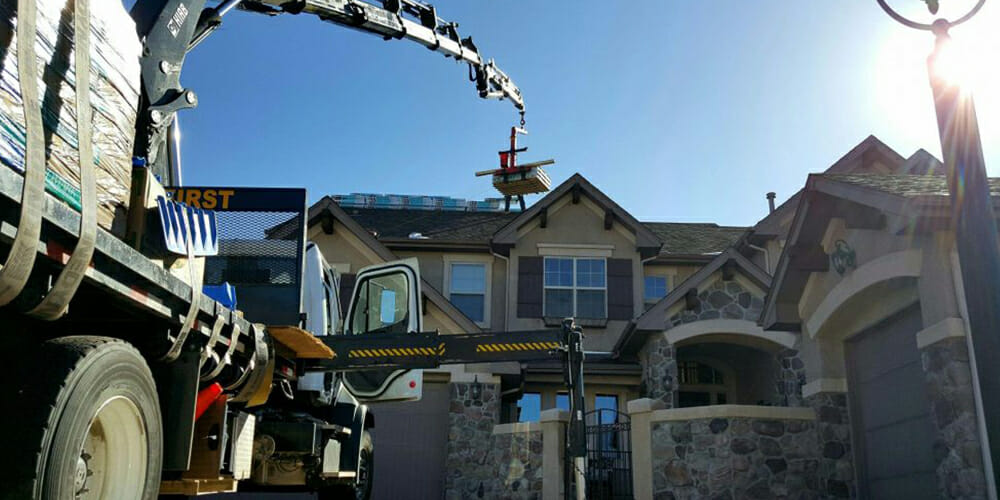Structural problems to a roof may be obvious to any observer and at other times that may be less obvious and only realized by a roof expert. In addition, the issue may be truly problematic or only cosmetic. Some issues will require immediate attention and others can be overlooked.
Sagging Roof
If the entire roof is sagging and it’s a roof structure that has been recently built the issue would could very well be an architects design flaw. There is a chance that the builder or framing contractor is responsible. It’s advisable to work with an architect that is familiar with the snow loads and best building practices for your area.
Sometimes architects will design a Colorado roof structure that only meets minimum standards for an area that should have more stringent building codes. This architect should space the rafters for a heavier snow load, thus installing the roof rafters closer together and or designing the build with wider lumber.
If you want to build a roof system for an unexpected weather related event than the roof has to be built with far better construction than the minimum building codes. Consider the following;
- Most of the roofs in Colorado Springs or Denver area are built to minimum specifications.
- Denver roofers should not be held responsible for conditions that pre-exist shingle installation.
- Roofers install shingles and rarely do they install the roof decking on new construction.
- The framer should install the decking according to the Architect’s design and builder’s instruction.
- Many of the roofs that are built in the higher country of Colorado should be installed with 5/8” or 3/4” decking.
- The roof could be sagging due to a builder or roofer cutting cost.
- These contractors could reduce expenses by employing cheap and untrained labor.
- Costs can be reduced with inferior products and less than minimum standards.
- For instance, if a framing crew chooses to install the roof deck without using an acceptable nail pattern this could lead to serious consequences.
Roof slope failure
This framing system that has failed may need the attention of an architect or engineer to correct the issues. There is a possibility that this roof system could be corrected, but it may or may not require the removal of the roofing material and deck. This would allow for the opportunity to install new framing members where the old members were.
There is a chance that the entire slope of the roof could be jacked up and a properly braced supporting beam to be held in place over a strong back on top of ceiling joist that expands to two vertical walls. A pony wall of some type would have to be created to carry the weight of the roof and distributed to the strong back which would distribute the weight over the walls. No matter what It still may be advisable to have an architect or engineer oversee this project. You’ll have to consult with your local building department for current requirements. You may find one of the many Denver roofers that might be willing and possibly qualified to assist in this endeavor, however we’d highly recommend that an Architect oversee the project.
Sagging Rafters
While inspecting a roof a small section of the roof may be sagging. This may be caused from a broken rafter. The rafter may break at a knot in the wood or the original framer installed an inferior board that should never have been used in the first place.
Some rafters in older construction may have been short nailed into the ridge board and slippage has occurred resulting in some sagging of the rafter. This framing member should have been securely fastened.
In either case a simple fix of jacking up the roof with a hydraulic jack that is stationed on top of an interior wall or supported by a temporary beam laid across many ceiling joists to span over the top plate of two walls may be used. Once everything is in position the rafter can be raised to it’s proper height and another rafter can be securely fastened to handle the weight of the roof system. This feat may be accomplished with an exceptionally qualified Denver roofer that possesses an unusual aptitude for engineering stresses and one that has a General contractor’s license. I’d still recommend the use of an engineer or an Architect to oversee the project.
It may be beneficial to install framing collars that expand from one rafter to the opposing rafter on the other side of the ridge board. This will help prevent tensile forces from pulling the rafters away from the ridge board. In addition, vertical purlin braces may help with lateral forces on long rafters to keep them from sagging.
Sagging Ridge Line
The sagging ridge line may be a result of a broken ridge board. If this is the case a pair of steel plates designed specifically to re-join the broken ridge board may be an adequate fix. The ridge board would have to be temporarily lifted and shored up while the steel plates are being bolted together through holes that are spaced properly to form a powerful bridge. It would be advisable to install some rafter collars and purlin braces in this area. Again, it might be wise to consult with a mechanical engineer on this project.
Rotted Wood
A simple and persistent water intrusion over a period of time may lead to structural damage on top of a roof. The water leak doesn’t necessarily have to be on top of the roof. A wall structure that has a water intrusion resulting in dry rot may begin to sag under the roof load. You may be able to see the roof sagging at the eave where the rafter tails sit on the exterior walls top plate and sagging occurs because of dry rot wishing the wall.
Roofing members and more specifically the rafter tails are an area where dry rot may occur. Again, what you may see is sagging at the roofs edge.
A more common issue is when the roof flashing doesn’t perform as intended and water intrusion occurs at the junction of a wall penetration and roof. As this occurs the water begins to rot out the roof decking. There are times when this can be observed from the ground. Most of the time when dry rot occurs on the roof deck it is discovered from a roof top inspection.
Roof Sheathing Delamitation and Swelling
Improper roof and attic ventilation is known to cause structural roof damage. A roof system needs to breath. The best way to do this is for the exterior air to be drawn up into the attic by soffit vents. Once in the attic this air should exit the roofs peak. Ridge vents and air hawks are two roof exhaust vents that perform well. There are other products on the market for ventilating attics and you may want to investigate which product combination works best for you.
OSB or CDX plywood expand and contract due to moisture levels. If the roof system or attic is unable to breath than moisture levels of the roof structure would exceed acceptable levels and begin to expand. This expansion can result in delimitation of plywood and swelling of the OSB. Both of these can become so extreme that the decking will need to be replaced and proper ventilation should be installed to prevent this from occurring again.
The roof system that isn’t ventilated properly should not be the responsibility of a Denver roofer. It was the responsibility of the builder and the architect. Consult with an architect to know what’s best for your roof design. There are no cookie cutter answers to resolving builder issues related to roof ventilation.
Cosmetic Decking Issue
Decking installed without expansion gaps results in buckling and telegraphing of the outline of the roof decking through the overlaying shingles. More than likely resulting in only an unsightly aesthetic issue. This can’t be repaired, it would have to be replaced.
Master Roofing Company
Integrity Roofing and Painting, LLC is one of only a handful of Denver roofing contractors that is classified as a Shingle Master Company. Contact us for your roof replacement.

